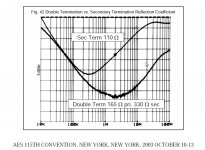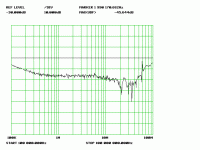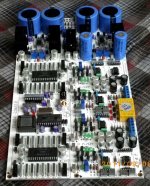Hi,
I disagree. His emphasis is correct. Especially for the CS/AK Chips.
Try measuring them...
Ciao T
Yes I've followed Jocko's writings with immense interest. He seems to me to put undue emphasis on waveform fidelity and ignore common-mode noise.
I disagree. His emphasis is correct. Especially for the CS/AK Chips.
So he disses (for example) the low interwinding capacitance designs of SC because such buy their low capacitance at the expense of higher leakage inductance.
Try measuring them...
Ciao T
I disagree. His emphasis is correct. Especially for the CS/AK Chips.
I'm curious to learn why the emphasis on waveform fidelity over CM noise. Any anecdotes to share?
Try measuring them...
They're not so easy to get hold of here so I'll pass on that. I prefer to roll my own solution and not (in general) to rely on a single source of boutique-style parts.
Hi,
Look at the way the various receivers trigger...
Too bad.
The difference between SPDIF transformers with screen and plain one sis quite large.
Ciao T
I'm curious to learn why the emphasis on waveform fidelity over CM noise. Any anecdotes to share?
Look at the way the various receivers trigger...
They're not so easy to get hold of here so I'll pass on that.
Too bad.
The difference between SPDIF transformers with screen and plain one sis quite large.
Ciao T
The difference between SPDIF transformers with screen and plain one sis quite large.
Scientific Conversion, Inc. - Transformers and Inductors
Which one(s) did you measure and what measurements did you make?
Hi,
I tested a different manufacturers screened and unscreened parts. The difference in leakage inductance is quite large. The larger leakage inductance makes getting a sufficiently bandwidth with optimum damping of ringing near impossible in practice.
Ciao T
Which one(s) did you measure and what measurements did you make?
I tested a different manufacturers screened and unscreened parts. The difference in leakage inductance is quite large. The larger leakage inductance makes getting a sufficiently bandwidth with optimum damping of ringing near impossible in practice.
Ciao T
If by 'You' you mean me, I've never had a SC part to evaluate. On paper they look impeccable, they even show jitter plots versus unnamed 'competitor' parts. But they're single sourced and a bit on the expensive side so I'm not a customer - yet.
Incidentally, when they say 'shielded' does that mean magnetically shielded or having an interwinding screen? I'd assume the former but it would be nice if they'd clarify this point.
Incidentally, when they say 'shielded' does that mean magnetically shielded or having an interwinding screen? I'd assume the former but it would be nice if they'd clarify this point.
Only because they call it differently, it is still a screening.
Look at the last figure in this document, what does pin 2 do in the application?
Scientific Conversion, Inc. - Transformers and Inductors
In their other documents earlier available on the net, they were even more explicit about it.
Ciao, George
P.S.: Did You notice also those ferrite beads on the input?
Look at the last figure in this document, what does pin 2 do in the application?
Scientific Conversion, Inc. - Transformers and Inductors
In their other documents earlier available on the net, they were even more explicit about it.
Ciao, George
P.S.: Did You notice also those ferrite beads on the input?
Last edited:
I downloaded their AES paper, yes they do show an explicit screen and they show it connected to earth on the schematic. What's unclear then is how the capacitance measurements apply - 3.0pF or 0.5pF and between which terminals?
Yes I noticed the ferrite beads and CM choke too, with CM suppressing caps after. Is there something wrong with using them? To me it shows they do take CM noise seriously.
Yes I noticed the ferrite beads and CM choke too, with CM suppressing caps after. Is there something wrong with using them? To me it shows they do take CM noise seriously.
nonlinear bandwith limiting ferrrrrrrrite beads on signal path? Do SC care about performance or EMI supression? 
Could be there another reason behind their marketing?

Could be there another reason behind their marketing?
Ah I begin to see a reason for Jocko not caring about CM noise so much. Thanks for the link. Its an issue for me though because I use el cheapo 99rmb DVD players as transports, they have el cheapo SMPSUs inside with minimal filtering.
In my experience its not either/or its both/and - a performing system is a suppressed one.
Do SC care about performance or EMI supression?
In my experience its not either/or its both/and - a performing system is a suppressed one.
Last edited:
Hi,
Ah I begin to see a reason for you being so concerned about CM noise.
I personally tend to fit a decent output stage WITH an optimised output transformer (and a Tube as buffer as it so happens) which already much reduces the common mode noise floating around on the SPDIF link...
I then like to combine this output with a signal conditioning circuit which incorporates a transformer (and that uses a Tube as Amplification device plus other secret sauce).
I also like to terminate the link very close to the BNC sockets.
There is after the fact a mild bandwidth limit introduced by the tubes, around 60MHz or so and the signal that goes through is "picture perfect", even using the next best thing to wet string as cable and violating impedances etc. grossly.
Ciao T
PS, the reason that I use Tubes for SPDIF is the same given by Dirk Pitt as reason why some angel wing clams glow in the dark under water in the movie Sahara (there are several scientific/factual errors in that scene but it gets the point across beautifully):
Dirk Pitt: "Tell you my theory is that they do because they can."
Its an issue for me though because I use el cheapo 99rmb DVD players as transports, they have el cheapo SMPSUs inside with minimal filtering.
Ah I begin to see a reason for you being so concerned about CM noise.
I personally tend to fit a decent output stage WITH an optimised output transformer (and a Tube as buffer as it so happens) which already much reduces the common mode noise floating around on the SPDIF link...
I then like to combine this output with a signal conditioning circuit which incorporates a transformer (and that uses a Tube as Amplification device plus other secret sauce).
I also like to terminate the link very close to the BNC sockets.
There is after the fact a mild bandwidth limit introduced by the tubes, around 60MHz or so and the signal that goes through is "picture perfect", even using the next best thing to wet string as cable and violating impedances etc. grossly.
Ciao T
PS, the reason that I use Tubes for SPDIF is the same given by Dirk Pitt as reason why some angel wing clams glow in the dark under water in the movie Sahara (there are several scientific/factual errors in that scene but it gets the point across beautifully):
Dirk Pitt: "Tell you my theory is that they do because they can."
Ah I begin to see a reason for Jocko not caring about CM noise so much. Thanks for the link. Its an issue for me though because I use el cheapo 99rmb DVD players as transports, they have el cheapo SMPSUs inside with minimal filtering.
In my experience its not either/or its both/and - a performing system is a suppressed one.
I have the legato looked inside briefly he does care about CM noise but deals with it before the transformer.
What's the expert's solution then? Are you at liberty to reveal it?
Well here is a hint. And I believed this prior to buying the Legato. Asynch-USB works best spitting out SPDIF. I know that sounds like blasephemy as we all hate SPDIF but when you share a computers ground you are going to have to add jitter even skipping spdif and using I2s direct. So take advantage of the sdif strengths, Jocko I think was public about the engineering marvel that the DIT4192 is, but you have to use it not just make a spot for it on the PCB.
There is a lot of stuff inside this Legato that are engenious and remind me of good old fashioed high-end CDP's, but I am staring to sound like a shill. I want so much to tear it apart and make a masterclocked NOS TDA1541 but am holding off untill the computer to i2s tchnoogy has matured with open source UAC2.0 for windows, lightpeak, hdmi, high ram fifo, whatever.
As far as the WM8805 boards I bought one too and I would like to set it up but I just don't understand the concept of how it could actually be running a synchronous pll/reclocking with "any freuqncy from 10mhz to 27mhz." Just haven't had the time to research it but one would think without software control there could be a lot of pitfalls iterfacing with an NOS 1541 setup? I think a quality transport and a cs8412 a safer bet for the old DAC's unless you really have a lot of time.
Last edited:
Well here is a hint. And I believed this prior to buying the Legato. Asynch-USB works best spitting out SPDIF. I know that sounds like blasephemy as we all hate SPDIF but when you share a computers ground you are going to have to add jitter even skipping spdif and using I2s direct.
You've successfully put your finger on the very reason I'm not an SPDIF hater like the rest of you
As far as the WM8805 boards I bought one too and I would like to set it up but I just don't understand the concept of how it could actually be running a synchronous pll/reclocking with "any freuqncy from 10mhz to 27mhz." Just haven't had the time to research it but one would think without software control there could be a lot of pitfalls iterfacing with an NOS 1541 setup? I think a quality transport and a cs8412 a safer bet for the old DAC's unless you really have a lot of time.
This board does use a CPU - I have mine now so I can say for sure. I also have a board from the same guy with 4 * TDA1543 (NOS) which I have the impression sounds better than a similar implementation done with CS8414. So I reckon the WM8805 is definitely worth persevering with.
This board does use a CPU - I have mine now so I can say for sure. I also have a board from the same guy with 4 * TDA1543 (NOS) which I have the impression sounds better than a similar implementation done with CS8414. So I reckon the WM8805 is definitely worth persevering with.
I've been contemplating getting that same TDA1541 board if its the same one I'm thinking of, just has I-out and you get to add your own I/V stage without hacking up the PCB?
I feel this is one of those rare moments when one can directly compare apples to apples, philosophy to philosophy.
In this thread, praising those SC transformers, there is an AES document linked in, written by Jon D. Paul, vice president of S.C.
At the end of the document, there is a graph showing the reflection loss performance of that design discussed here, with those ferrrite beads.
The mesurement was done by an HP3577 vector network analyzer, the same one that happens to be used by Jocko Homo, too.
And yes, he had used it to measure the output return loss of his Legato device.
The first is the return loss graph, of the S.C. setup, the second is the output return loss
as measured by Jocko. Because they use different vertical resolution, the result is that the S.C. graph, once projected onto the one of the Ar-T, would touch the -30dB black reference line only in one small zone...
The simple, ferrite beaded 110ohm version, I would call an "open end" for all practical purposes above 1MHz.
In this thread, praising those SC transformers, there is an AES document linked in, written by Jon D. Paul, vice president of S.C.
At the end of the document, there is a graph showing the reflection loss performance of that design discussed here, with those ferrrite beads.
The mesurement was done by an HP3577 vector network analyzer, the same one that happens to be used by Jocko Homo, too.
And yes, he had used it to measure the output return loss of his Legato device.
The first is the return loss graph, of the S.C. setup, the second is the output return loss
as measured by Jocko. Because they use different vertical resolution, the result is that the S.C. graph, once projected onto the one of the Ar-T, would touch the -30dB black reference line only in one small zone...
The simple, ferrite beaded 110ohm version, I would call an "open end" for all practical purposes above 1MHz.
Attachments
Last edited:
I've been contemplating getting that same TDA1541 board if its the same one I'm thinking of, just has I-out and you get to add your own I/V stage without hacking up the PCB?
Mine's not 1541, I don't play with that chip as its kinda unavailable in the longer term. Do you mean this one:
Attachments
- Status
- This old topic is closed. If you want to reopen this topic, contact a moderator using the "Report Post" button.
- Home
- Source & Line
- Digital Line Level
- WM8805 upgrade board (cs8414 pins) - dissapointed



